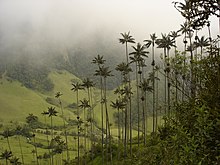Ceroxyloideae
| Ceroxyloideae | ||||||||||||
|---|---|---|---|---|---|---|---|---|---|---|---|---|

|
||||||||||||
| Systematics | ||||||||||||
|
||||||||||||
| Scientific name | ||||||||||||
| Ceroxyloideae | ||||||||||||
| Drude |
The Ceroxyloideae are a subfamily of the palm family (Arecaceae).
features
The representatives are large or stemless, single-stemmed palms, very rarely multi-stemmed. They are hermaphroditic or diocesan . The leaves are pinnate with reduplikaten leaflets (split of the leaf along the abaxial edges). A crown shaft can be formed or absent. The inflorescence has a cover sheet and one to several bracts on the inflorescence stalk. The bracts along the inflorescence axis are greatly reduced. The flowers are sessile or have a short stem. They stand individually or, if in groups, the group is monopodial , not sympodial . The flowers are never in pits. Single-sex flowers are slightly to strongly dimorphic. The Gynoeceum is synkarp (fused leaves) with three or more fruit compartments and three or more ovules . The endosperm of the seeds is homogeneous.

distribution
The three tribes of the subfamily each have their own distribution area: The Cyclospatheae are restricted to the Caribbean , the Phytelepheae occur in the Andes , and the Ceroxyleae occur in the areas of the former Gondwana : Andes, Juan Fernández Islands , Madagascar and North -Australia.
Systematics
The Ceroxyloideae in the sense of Dransfield et al. (2008) are identified as a natural family group ( Monophylum ) in numerous studies . They are the sister group of the Arecoideae . The subfamily consists of three tribes . The Phytelepheae were long run as a separate subfamily Phytelephantoideae, but in cladistic analyzes they always come within the Ceroxyloideae. Therefore they were placed as a tribe to the Ceroxyloideae. The relationship between the tribes is as follows:
|
|
|
||||||||||||
|
|
For a list of the eight genera see palm trees .
supporting documents
- John Dransfield, Natalie W. Uhl, Conny B. Asmussen, William J. Baker, Madeline M. Harley, Carl E. Lewis: Genera Palmarum. The Evolution and Classification of Palms . Second edition, Royal Botanic Gardens, Kew, 2008, ISBN 978-1-84246-182-2 , p. 333.
Individual evidence
- ^ John Dransfield, Natalie W. Uhl, Conny B. Asmussen, William J. Baker, Madeline M. Harley, Carl E. Lewis: Genera Palmarum. The Evolution and Classification of Palms . Second edition, Royal Botanic Gardens, Kew, 2008, ISBN 978-1-84246-182-2 , pp. 114f.
